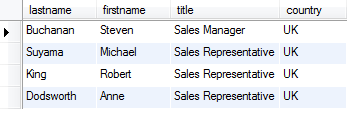

Select Case When = 1 OR = 1 And = 1 Then 'T' Here's an example to illustrate: Declare tinyInt = 1

SELECT *Įxample 2: And has precedence over Or, so, even if a a1 Or a2, Where a And b is not the same as Where a1 Or a2 And b, because that would be Executed as Where a1 Or (a2 And b) and if you're doing the following to make them all the same (using parentheses to override rules of precedence) Where (a1 Or a2) And b : (Second condition) have the role ‘Manager’ and whose salary is higher than 8000. The AND operator in SQL Server takes priority over the OR operator (just like a multiplication operation takes precedence over an addition operation).Įxample 1: The employee list is displayed using the SQL Server SELECT command below:

SQL AND | OR Conditions Combined Together SELECT * FROM Employee WHERE Salary >= 27000 AND Salary <= 30000 For instance, if you wish to locate employees with salaries between 2700 in the Employee table, you can use the AND operator as indicated in the query below. While dealing with SQL Server tables, you may have discovered how the AND operator works.Įxample 3: Use the logical AND operator to pick rows that must fulfill all of the specified constraints. TRUEĬondition 2: StateProvince = “Landon” i.e. You can see only those records were returned where both the provided conditions were TRUE.Ĭondition 1: CountryRegion = “United Kindom” i.e. WHERE CountryRegion ='United Kingdom' AND StateProvince = 'London' Examine the SQL statement below: SELECT TOP (1000) įROM.
Sql not equal to multiple values how to#
Let's look at how to apply this operator in a SELECT statement. Right now it doesn't know how to do that.The AND operator's result in many scenarios It'd be nice if PostgreSQL could automatically recognise a preposterously long IN clause or chain of similar AND conditions and switch to a smarter approach like doing a hashed join or implicitly turning it into a CTE node. parsing the VALUES list took almost no time at all, performing the same or slightly faster than the table approach in most tests. What surprised me was how fast doing it with a CTE using a VALUES list was. you can see that there's a truly huge gap between both IN and AND lists vs doing a proper join. Examination of the plan shows that Pg translates NOT IN to ALL.Subquery and join based table exclusion were much the same across repeated runs.AND list generated with SELECT string_agg(item::text, ' AND item ') from exclude ).IN list generated with SELECT 'IN (' || string_agg(item::text, ',' ORDER BY item) || ')' from exclude.making the CTE-based approach over three thousand times faster than the AND list and 130 times faster than the NOT IN list.Ĭode here: (shield your eyes, ye who follow this link).įor this data set size adding an index on the exclusion list made no difference. Subquery table based, no index on ex-list: 23.985.Table-based JOIN, no index on ex-list: 25.183.VALUES based subquery exclusion: 20.495.I then compare the following approaches on the same data with all results in milliseconds: Where exclude is the list of values to omit. INSERT INTO exclude_test(id) SELECT generate_series(1,50000) ĬREATE TABLE exclude AS SELECT x AS item FROM generate_series(1,40000,4) x At this point you should consider creating a TEMPORARY table, COPYing the data to exclude into it, possibly creating an index on it, then using one of the above approaches on the temp table instead of the CTE.ĭemo: CREATE UNLOGGED TABLE exclude_test(id integer primary key)

If the value list is long enough (many tens of thousands of items) then query parsing may start having a significant cost. (On modern Pg versions both will produce the same query plan anyway). LEFT OUTER JOIN excluded e ON (t.item = e.item) WHERE NOT EXISTS(SELECT 1 FROM excluded e WHERE t.item = e.item) In both cases, if they're long enough for you to even be asking the question you should be doing an anti-join or subquery exclusion test over a value list instead. lists and very long NOT IN lists both perform terribly, with AND much worse than NOT IN. In PostgreSQL there's usually a fairly small difference at reasonable list lengths, though IN is much cleaner conceptually.


 0 kommentar(er)
0 kommentar(er)
